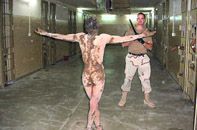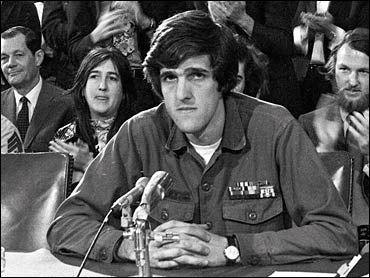Crossposted from MY LEFT WING


I've been spending more time with my family and much less online these past few days, so this may not news to anyone but me, but I read a long, in-depth article in today's Los Angeles Times and literally had to concentrate to keep from throwing up.
What made it all the more horrifying for me, on a personal level, was that the focal point of this report, the atrocities spotlighted in it, took place on the same day my father was killed in Vietnam. While he led his Alpha Company Marines against the brutal and futile siege at Khe Sanh, several members of the U.S. Army's B Company participated in a grotesque massacre of 19 and innocent civilians -- old men, young women, children and babies.
And, even irrespective of the infamous massacre at My Lai, this newly revealed atrocity was not an isolated incident. Not by a long shot.

... Now, nearly 40 years later, declassified Army files show that Henry was telling the truth -- about the Feb. 8 killings and a series of other atrocities by the men of B Company.
The files are part of a once-secret archive, assembled by a Pentagon task force in the early 1970s, that shows that confirmed atrocities by U.S. forces in Vietnam were more extensive than was previously known.
The documents detail 320 alleged incidents that were substantiated by Army investigators -- not including the most notorious U.S. atrocity, the 1968 My Lai massacre.
. . .
Among the substantiated cases in the archive:
* Seven massacres from 1967 through 1971 in which at least 137 civilians died.
* Seventy-eight other attacks on noncombatants in which at least 57 were killed, 56 wounded and 15 sexually assaulted.
* One hundred forty-one instances in which U.S. soldiers tortured civilian detainees or prisoners of war with fists, sticks, bats, water or electric shock.
. . .
On Oct. 8, 1967, after a firefight near Chu Lai, members of his company spotted a 12-year-old boy out in a rainstorm. He was unarmed and clad only in shorts.
"Somebody caught him up on a hill, and they brought him down and the lieutenant asked who wanted to kill him," Henry told investigators.
Two volunteers stepped forward. One kicked the boy in the stomach. The other took him behind a rock and shot him, according to Henry's statement. They tossed his body in a river and reported him as an enemy combatant killed in action.
Three days later, B Company detained and beat an elderly man suspected of supporting the enemy. He had trouble keeping pace as the soldiers marched him up a steep hill.
"When I turned around, two men had him, one guy had his arms, one guy had his legs and they threw him off the hill onto a bunch of rocks," Henry's statement said.
On Oct. 15, some of the men took a break during a large-scale "search-and-destroy" operation. Henry said he overheard a lieutenant on the radio requesting permission to test-fire his weapon, and went to see what was happening.
He found two soldiers using a Vietnamese man for target practice, Henry said. They had discovered the victim sleeping in a hut and decided to kill him for sport.
"Everybody was taking pot shots at him, seeing how accurate they were," Henry said in his statement.
Back at base camp on Oct. 23, he said, members of the 1st Platoon told him they had ambushed five unarmed women and reported them as enemies killed in action. Later, members of another platoon told him they had seen the bodies.
. . .
The next morning, the men packed up their gear and continued their sweep of the countryside. Soldiers discovered an unarmed man hiding in a hole and suspected that he had supported the enemy the previous day. A soldier pushed the man in front of an armored personnel carrier, Henry said in his statement.
"They drove over him forward which didn't kill him because he was squirming around, so the APC backed over him again," Henry's statement said.
Then B Company entered a hamlet to question residents and search for weapons. That's where Henry set down his weapon and lighted a cigarette in the shelter of a hut.
A radio operator sat down next to him, and Henry was listening to the chatter. He heard the leader of the 3rd Platoon ask Reh for instructions on what to do with 19 civilians.
"The lieutenant asked the captain what should be done with them. The captain asked the lieutenant if he remembered the op order (operation order) that came down that morning and he repeated the order which was 'kill anything that moves,' " Henry said in his statement. "I was a little shook ... because I thought the lieutenant might do it."
Henry said he left the hut and walked toward Reh. He saw the captain pick up the phone again, and thought he might rescind the order.
Then soldiers pulled a naked woman of about 19 from a dwelling and brought her to where the other civilians were huddled, Henry said.
"She was thrown to the ground," he said in his statement. "The men around the civilians opened fire and all on automatic or at least it seemed all on automatic. It was over in a few seconds. There was a lot of blood and flesh and stuff flying around..."
"I looked around at some of my friends and they all just had blank looks on their faces.... The captain made an announcement to all the company, I forget exactly what it was, but it didn't concern the people who had just been killed. We picked up our stuff and moved on."
. . .
I can't go on. Reading this, I felt nothing so much as the keen sense that all the barbarism we watch on the History channel, from which we feel so removed, is still very much alive within our species. And I cannot make sense of it. I do not know what it is that allows some human beings to perpetrate cruelties upon others, or upon animals, or, taken to the logical conclusion, upon the earth itself. I know only that I am also a human being, but not one of them.
Oh, yes, I feel superior -- to the extent that one takes pride in having overcome those baser instincts now relegated to the status of "inhumane." But wait -- what's this I see? Rows and rows of leather shoes in my closet; a freezer full of animal flesh, killed and packaged neatly so I might believe myself "above" the barbarism...
Abuses were not confined to a few rogue units, a Times review of the files found. They were uncovered in every Army division that operated in Vietnam.
That's the trajectory of my thoughts of late. It all comes back to me, to my own hypocrisy. I am horrified by the "inhumanity" of man toward man and beast and land, but everywhere I look, in the crevices and mesas of my own existence, I find microcosmic reflections of it.
But this isn't therapy... not now. I'll leave you with the most sensible statement I've read from a military man in a long time, taken from the same Los Angeles Times article that left me reeling in pain and confusion and despair:
Retired Brig. Gen. John H. Johns, a Vietnam veteran who served on the task force, says he once supported keeping the records secret but now believes they deserve wide attention in light of alleged attacks on civilians and abuse of prisoners in Iraq.
"We can't change current practices unless we acknowledge the past," says Johns, 78.
All emphases in quoted material are mine.


